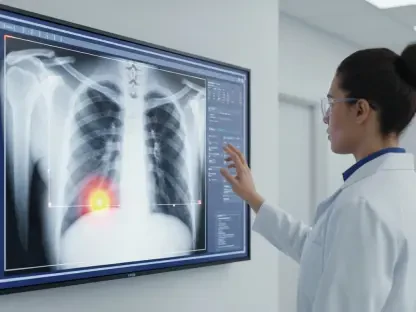The biopharmaceutical contract research organization (CRO) market is experiencing transformative growth, driven by rapid technological advancements and evolving consumer demands. Understanding these trends is essential for stakeholders looking to navigate and capitalize on this dynamic industry.
Analyzing the Biopharmaceutical CRO Market
The Importance of FNPV Matrix Analysis
The Fair Net Present Value (FNPV) Matrix Analysis serves as a cornerstone in evaluating investment potential within the biopharmaceutical CRO market. This methodology assesses financial returns, considering the time value of money and projected cash flows. It allows investors to pinpoint lucrative segments and optimize resource allocation. This comprehensive approach to investment analysis is vital in a market characterized by swift technological changes and varied consumer demands.
FNPV Matrix Analysis is especially valuable in a market marked by swift technological changes. Companies can gauge the viability of new technologies and services, helping them stay ahead of the competition. Additionally, this analysis helps stakeholders identify high-risk areas, enabling more informed decision-making. It provides a structured framework for assessing the economic viability of different segments within the biopharmaceutical CRO market, ensuring that investments are channeled into areas with the highest potential returns.
Market Segmentation by Type
The biopharmaceutical CRO market can be broadly divided into two main types: full-service CROs and specialized CROs. Full-service CROs offer a comprehensive suite of services, from initial drug discovery to post-market surveillance. This all-encompassing approach appeals to large enterprises seeking integrated solutions, as it simplifies the process by having a single CRO handle various phases of drug development. These companies benefit from the economies of scale and streamlined processes that full-service CROs provide.
On the other hand, specialized CROs focus on niche areas such as clinical trials, regulatory consulting, and laboratory services. These organizations cater predominantly to small and medium-sized businesses (SMBs) that require specific expertise. The specialization allows for high-quality, targeted results, fostering growth in particular niches. Specialized CROs often provide customized solutions that meet the specific requirements of their clients, enhancing the precision and efficacy of biopharmaceutical research and development efforts.
Market Segmentation by Application
Differentiating the market by application provides additional insights. Large enterprises, with their substantial budgets and expansive reach, often dominate the market landscape. Their requirement for wide-ranging services from full-service CROs drives significant demand. These enterprises typically seek end-to-end solutions that streamline the drug development process, reduce time-to-market, and ensure regulatory compliance across different jurisdictions.
Conversely, SMBs face unique challenges, such as limited resources and a higher need for specialized services. Specialized CROs meet these needs by offering expertise and flexibility that larger CROs might not. This segmentation highlights growth opportunities for specialized CROs serving SMBs. By providing more personalized and agile services, specialized CROs can cater to the distinct needs of SMBs, empowering them to navigate the complexities of drug development more effectively and efficiently.
Key Analytical Methods in Market Insights
Utilizing Financial Performance Analysis
Financial performance analysis is crucial in understanding the market dynamics. By assessing the revenue, profit margins, and investment returns of key players, stakeholders gain a clearer picture of the market’s financial health. This analysis also reveals trends that affect market stability and growth forecasts. Understanding these financial parameters helps investors and companies make informed decisions about where to allocate resources and which market segments to target for growth.
For instance, companies with consistent revenue growth and robust profit margins are more likely to attract investor interest. Conversely, organizations with fluctuating financial performance may need to reassess their strategies to remain competitive. This analysis provides an overview of which companies are thriving and which ones are struggling, offering valuable insights into market trends and the overall economic landscape of the biopharmaceutical CRO industry.
The Role of SWOT Analysis
Strengths, Weaknesses, Opportunities, and Threats (SWOT) analysis offers a structured approach to evaluating market players. Strengths and weaknesses provide an internal view, helping companies leverage their advantages and address deficiencies. Opportunities and threats assess external factors, such as regulatory changes and market competition. This approach is crucial for identifying potential challenges and opportunities in the market.
SWOT analysis is indispensable for navigating the biopharmaceutical CRO market. By understanding their position and external influences, companies can develop strategies to capitalize on growth opportunities and mitigate potential risks. It provides a holistic view of the market, enabling companies to make strategic decisions that align with their strengths and address their weaknesses, ultimately fostering sustainable growth and resilience in a competitive market.
Competitive Landscape Analysis
Competitive landscape analysis delves into the strategies, strengths, and weaknesses of key market players. This method provides insights into how companies position themselves and compete within the market. By analyzing competitors’ approaches, firms can benchmark their performance and identify areas for improvement. This type of analysis is vital for understanding the competitive dynamics and identifying best practices in the industry.
For example, assessing the competitive strategies of major players like WuXi AppTec and ICON can reveal successful business models. Smaller companies can adapt these strategies to enhance their market presence and drive growth. By understanding the competitive landscape, companies can develop strategies to differentiate themselves, capture market share, and respond effectively to competitive pressures.
Emerging Trends in the Biopharmaceutical CRO Market
Technological Advancements
Technological innovation is a primary driver of growth in the biopharmaceutical CRO market. Advancements in artificial intelligence, machine learning, and automation are revolutionizing drug discovery and development processes. These technologies enhance efficiency, reduce costs, and improve accuracy in research outcomes. Companies that invest in cutting-edge technologies are better positioned to offer advanced services, attracting more clients and staying competitive in a rapidly evolving market.
The integration of these advanced technologies enables CROs to accelerate drug development timelines, improve data analytics, and enhance patient recruitment and retention in clinical trials. Additionally, technological advancements help CROs to comply with regulatory requirements more efficiently, reducing the time and cost associated with obtaining approvals for new therapies. By leveraging these innovations, CROs can deliver higher-quality outcomes and create value for their clients, ultimately driving growth and competitiveness in the market.
Evolving Consumer Demands
Consumer demands in the biopharmaceutical sector are continually changing. Today’s consumers are more informed and have higher expectations for quality and transparency. This shift influences the types of services that CROs must offer, pushing them towards more personalized and patient-centric approaches. CROs must adapt to these demands by adopting innovative solutions and ensuring high standards of service. Meeting consumer expectations can lead to increased client loyalty and new business opportunities.
Furthermore, the rise of patient advocacy and the demand for more patient-centric clinical trials are reshaping the landscape of the biopharmaceutical CRO market. Patients and advocacy groups increasingly participate in the design and implementation of clinical trials, emphasizing the importance of patient experience and outcomes. CROs that prioritize patient engagement and transparency in their processes are more likely to build trust and long-term relationships with clients and patients alike.
Key Market Players and Their Strategies
WuXi AppTec and WuXi Biologics
WuXi AppTec and WuXi Biologics are major players in the biopharmaceutical CRO market, known for their comprehensive range of services and global reach. Their strategies focus on technological investment and expanding their service portfolios to meet diverse client needs. These companies’ strong financial performance and extensive client base underscore their market leadership. By analyzing their strategies, other firms can identify best practices and potential areas for growth.
Both WuXi AppTec and WuXi Biologics emphasize research and development, aiming to stay at the forefront of technological advancements in the biopharmaceutical industry. Their global presence enables them to serve a wide range of clients, from large pharmaceutical companies to smaller biotech firms. By maintaining a robust pipeline of innovative projects and continually expanding their capabilities, these companies remain competitive and influential in the market, setting benchmarks for others to follow.
Specialized CROs and Niche Services
Specialized CROs focus on providing niche services within the biopharmaceutical market. They cater primarily to small and medium-sized businesses by offering targeted expertise in areas such as clinical trials, regulatory consulting, and laboratory services. These organizations thrive on their ability to deliver high-quality, customized solutions that address the unique needs of their clients. By specializing in specific areas of biopharmaceutical research and development, these CROs can offer more precise and effective services than their full-service counterparts.
These specialized CROs often operate with a high degree of flexibility, allowing them to adapt quickly to changing market conditions and client requirements. Their deep expertise in specific areas of biopharmaceutical research enables them to deliver superior results, making them valuable partners for SMBs looking to navigate the complex landscape of drug development. By focusing on niche markets and building strong relationships with their clients, specialized CROs can achieve significant growth and drive innovation in the biopharmaceutical industry.
Conclusion
The biopharmaceutical contract research organization (CRO) market is undergoing a significant transformation, fueled by the rapid pace of technological advancements and shifting consumer expectations. Technological innovation is reshaping the landscape, enabling more efficient processes, robust data analysis, and accelerated timelines for drug development. This evolution is not only optimizing operations but also enhancing the accuracy of clinical trials and regulatory compliance. As healthcare consumers become more informed and discerning, their increasing demand for personalized medicine and advanced treatment options is further propelling the market.
Understanding these dynamic trends is crucial for stakeholders aiming to successfully navigate this burgeoning industry. Companies that can adapt quickly to these technological changes and meet evolving consumer demands will be well-positioned to gain a competitive edge. They need to stay agile, investing in cutting-edge technologies and maintaining a keen focus on quality and compliance. By doing so, they can harness the full potential of the biopharmaceutical CRO market’s transformation and drive substantial growth in this ever-evolving field.









